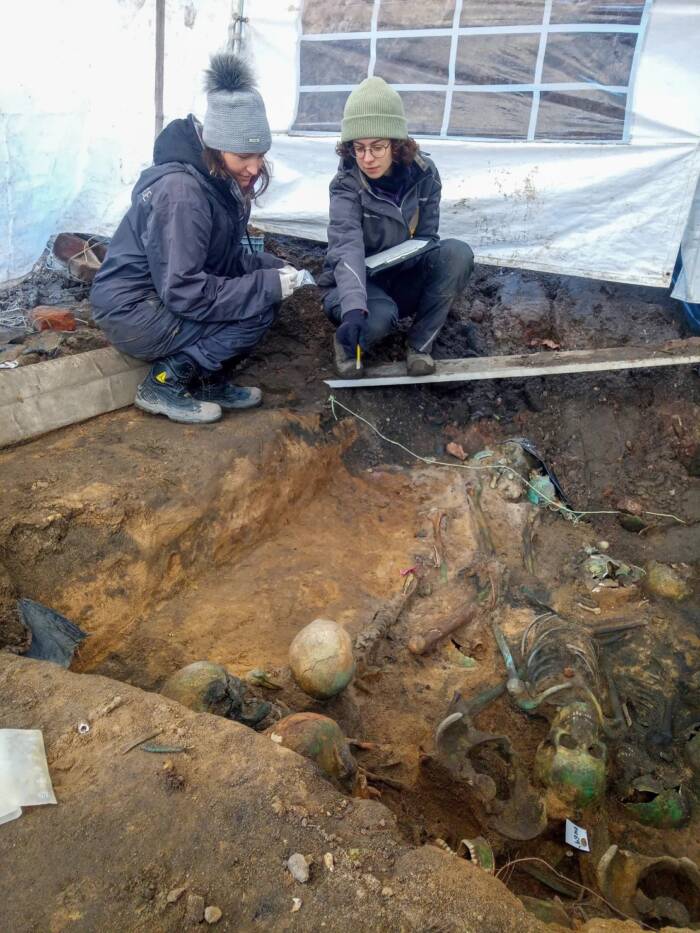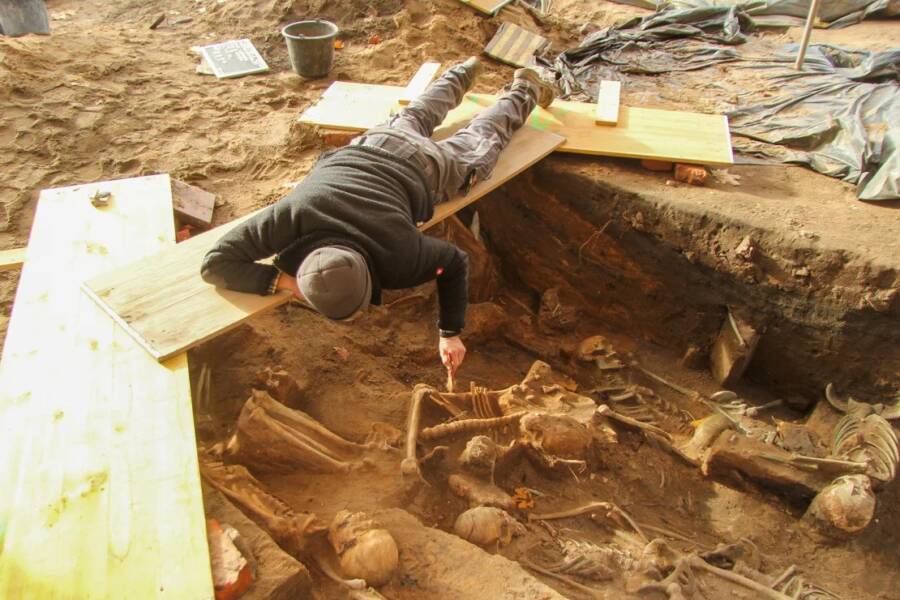
In Terra VeritasThis mass grave of plague victims in Nuremberg, Germany contains the skeletons of hundreds of men, women, and children.
Prior to the construction of residential buildings in Nuremberg, Germany, archaeologists conducted a routine survey at the site. There, they made a gruesome discovery — the remains of over 1,000 people, probably plague victims, in what might be the largest mass grave ever discovered in Europe.
Experts are still examining the remains, but they believe that the victims perished during one of Nuremberg’s many brushes with the bubonic plague.
Discovering The Mass Grave Of Plague Victims In Nuremberg
Archaeologists didn’t expect to find much when they surveyed a site in Nuremberg designated for new retirement homes. According to Der Spiegel, they thought it was possible that they might find border fortifications from the Thirty Years War (1618 to 1648) or perhaps the remains of a 19th-century children’s home. Instead, they started finding skeletons — hundreds of them.
The mass grave contained the remains of men and women, children and adults, many of the bones an eerie green from a nearby copper mill. Some of the skeletons were buried clothed, and archaeologists also discovered buttons, buckles, hooks, and coins alongside the hundreds of bodies.

In Terra VeritasSome of the bones have a green tinge because of the site’s proximity to a nearby copper mill.
“To be honest, I did not realize what we had there,” Julian Decker, whose company In Terra Veritas conducted the excavations, told All That’s Interesting in an email.
“We saw a handful of human bones and first thought it must be victims of the bombing of Nuremberg in 1943. So we informed the authorities and just for safety got a radiocarbon dating from one of the bones.”
To their surprise, the radiocarbon dating suggested that the bones were from much earlier — between the late 15th century and early 17th century.
“Then it struck that we might have something very important there,” Decker told All That’s Interesting, adding: “No one expected there to be graves or even mass graves filled with hundreds of bodies. So the surprise was quite overwhelming when we figured out what was hidden there.”
To date, roughly 1,000 skeletons in eight grave pits have been excavated from the site. But archaeologists are confident that there are hundreds more people buried there. Decker told CNN that there could be more than 1,500 skeletons at the site — he personally suspects the number to be over 2,000 — which would make the mass grave the largest ever found in Europe.
So, who are the hundreds of people buried in the grave? Archaeologists believe that they’re 17th-century victims of the bubonic plague.
Dating And Identifying The Remains
To determine the provenance of the mass grave, experts looked at a couple of clues. For starters, there was the method of burial — haphazardly and without ceremony. Children were stuffed in between adults, skeletons were buried in stacks, and none appeared to be buried on their backs with their hands folded on their chests, per Christian tradition.
From this, researchers began to suspect that they were plague victims.

In Terra VeritasThe skeletons were buried haphazardly and without ceremony, suggesting that they were interred in a rush.
“For people to be buried outside of a cemetery in mass graves without regard to Christian burial rites there must have been special circumstances,” Melanie Langbein of Nuremberg’s Department for Heritage Conservation told All That’s Interesting in an email. “[A] plague epidemic was one of the few possibilities. The problem was that Nuremberg had a plague epidemic roughly every ten years from the mid 1300s.”
Researchers were able to narrow the time frame down with radiocarbon dating, which suggested that the skeletons had been buried between 1474 and 1638. They also found coins at the site from between 1619 and 1621. Thus, it stands to reason that the mass grave came from 1632 to 1633, when Nuremberg suffered from an especially devastating wave of the plague.
“That epidemic was the worst one Nuremberg had with over 15,000 dead out of a population of 50,000,” Langbein told All That’s Interesting.
Then, the city was surrounded by troops fighting in the Thirty Years War, which meant that people from the surrounding villages fled into the city. “Living conditions became quite crammed, which provided the optimal breeding ground for the plague,” Langbein explained to All That’s Interesting.
What’s more, historical documents suggest that 2,000 of these plague victims were buried near St. Sebastian Hospital — where the mass grave was uncovered.
“This hospital is about 50 meters away from us,” Decker told All That’s Interesting, “so we are quite sure to have identified said burials.”
Archaeologists plan to complete the excavation and then study the skeletons. The plague victims provide a fascinating cross-section of 17th-century German society — being from all classes and all ages — and researchers are looking forward to learning more about their diet, health, and other attributes.
“With the remains of over a thousand people already documented and probably a thousand more to come we have a statistical relevant portion of the population of Nuremberg, children, adults, elderly, men and women,” Langbein told All That’s Interesting.
“We’re looking beyond age, gender and height to see if there are pathological changes regarding sickness, deficiencies, wear, and stress.”
After reading about the mass grave discovered in Nuremberg, go inside the question of how many people died from the bubonic plague. Or, discover the story behind the plague doctors who treated Black Death victims.





